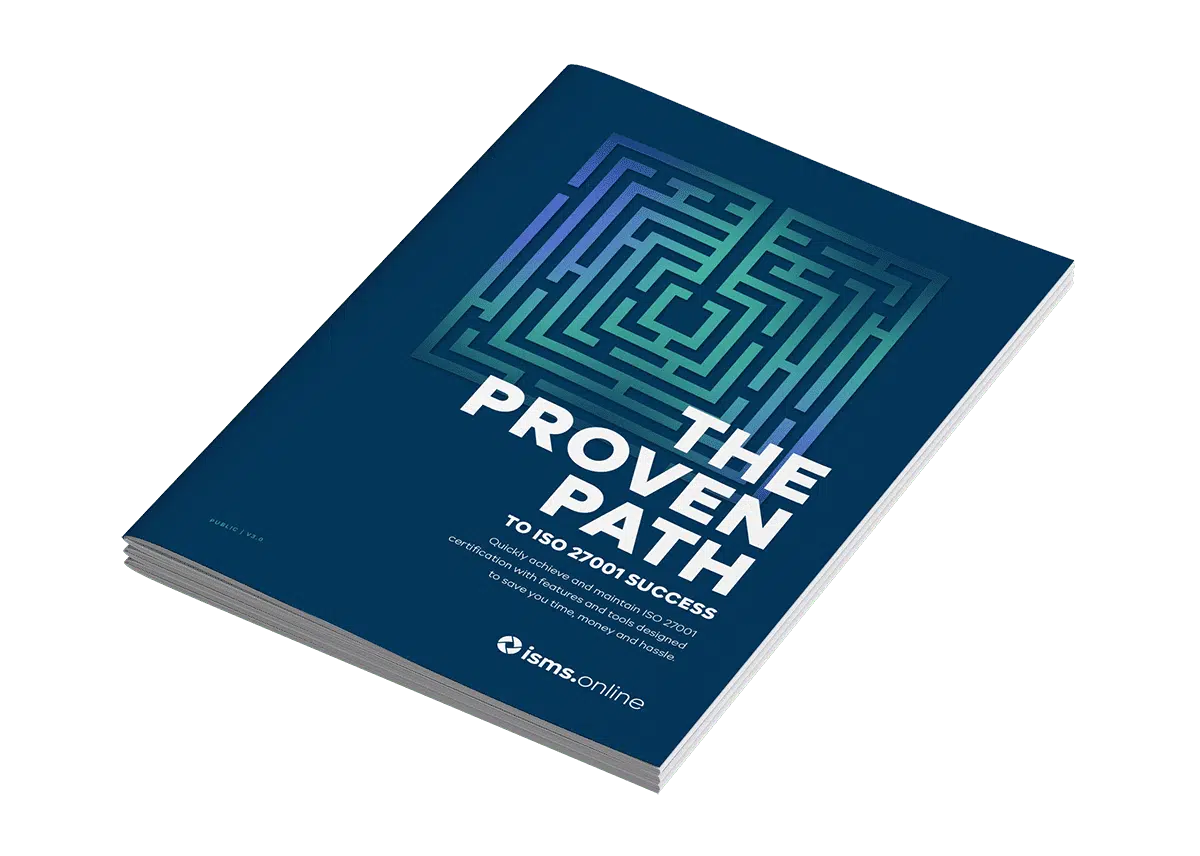
בדרך כלל נעשה שימוש בביקורות כדי לוודא שפעילות עומדת בסט של קריטריונים מוגדרים. עבור כל תקני מערכת הניהול ISO, נעשה שימוש בביקורות על מנת להבטיח שמערכת הניהול עומדת בדרישות התקן הרלוונטי, בדרישות וביעדי הארגון עצמו, ונותרה יעילה ואפקטיבית. יהיה צורך לערוך תוכנית של ביקורות כדי לאשר זאת.
An ISO 27001 הביקורת כוללת מבקר מוסמך ואובייקטיבי הבודק:
בנוסף לתאימות הכללית והיעילות של ה-ISMS, as ISO 27001 נועד לאפשר לארגון לנהל את סיכוני אבטחת המידע שלו לרמה נסבלת, יהיה צורך לבדוק שהבקרות המיושמות אכן מפחיתות את הסיכון עד לנקודה שבה בעלי הסיכון שמחים לסבול את הסיכון השיורי.
התקן מחייב שארגון נדרש לתכנן ולערוך לוח זמנים של "ביקורות פנימיות" כדי שיוכל לטעון לעמידה בתקן. יתר על כן, אם ארגון מעוניין להשיג הסמכה, הוא ידרוש "ביקורות חיצוניות" שיבוצעו על ידי "גוף הסמכה" - ארגון בעל משאבי ביקורת מוסמכים מול ISO 27001.
כדי להבטיח תועלת מרבית מה-ISMS, מומלץ מאוד לוודא שגוף ההסמכה שנבחר יהיה מוסמך על ידי רשות מפקחת מוכרת. בתוך בריטניה, גופי הסמכה מוסמכים על ידי UKAS - שירות ההסמכה של בריטניה.
ביקורות פנימיות, כפי שהשם מרמז, הן אותן ביקורות המבוצעות על ידי המשאבים של הארגון. אם לארגון אין מבקרים מוסמכים ואובייקטיביים בתוך הצוות שלו, ביקורות אלו יכולות להתבצע על ידי ספק בחוזה. אלה מכונים לעתים קרובות "ביקורות צד שני" מכיוון שהספק פועל כ"משאב פנימי".
המונח "ביקורות חיצוניות" מתייחס לרוב לאותן ביקורות המבוצעות על ידי גוף הסמכה כדי להשיג או לשמור על הסמכה. עם זאת, המונח עשוי לשמש גם כדי להתייחס לאותן ביקורות שבוצעו על ידי גורמים מעוניינים אחרים (למשל שותפים או לקוחות) המעוניינים לקבל ביטחון משלהם לגבי ה-ISMS של הארגון. הדבר נכון במיוחד כאשר לגורם כזה יש דרישות החורגות מאלה של התקן.
עשינו יותר התקדמות ISO 27001 בשבועיים האחרונים באמצעות ISMS.online מאשר בשנה האחרונה.
מבלי לוודא כיצד ה-ISMS שלך מנוהל ומתפקד, אין ערובה אמיתית להבטחה שהיא מספקת מול היעדים שהוא מוגדר להגשים.
ביקורת מובילה במידה מסוימת לספק את הבטחון הזה.
ישנן סיבות רבות לביקורת ה-ISMS שלך:

הורד את המדריך בחינם שלך להסמכה מהירה ובר קיימא

אנחנו רק צריכים כמה פרטים כדי שנוכל לשלוח לך בדוא"ל את המדריך שלך להשגת ISO 27001 בפעם הראשונה
הורד את המדריך החינמי שלך עכשיו ואם יש לך שאלות בכלל אז הזמן הדגמה or צור קשר. נשמח לעזור.
אם אינך משתמש ב-ISMS.online, אתה הופך את חייך לקשים יותר ממה שהם צריכים להיות!
התהליכים לביקורת חיצונית זהים בעיקרם לתוכנית הביקורת הפנימית אך מבוצעים בדרך כלל כדי להשיג ולתחזק הסמכה.
תכנית הביקורות החיצוניות [הסמכה] תיקבע על ידי המבקרים החיצוניים [גוף ההסמכה] אך תפעל לפי דרישה שיטתית (ראה להלן).
המבקר הרלוונטי יספק תוכנית של הביקורת, ולאחר שהארגון יאשר זאת, יוקצו משאבים ויסוכמו תאריכים, שעות ומיקומים.
לאחר מכן הביקורת תיערך בהתאם לתוכנית הביקורת.
גופי הסמכה שונים ברחבי העולם קובעים דרישות שונות לתוכנית ביקורת ההסמכה; עם זאת, במקרה של תעודות מוסמכות UKAS, זה יכלול:
בנוסף לתוכנית הביקורת החיצונית של ההסמכה הרשמית לעיל, ייתכן שתידרש לעבור ביקורת חיצונית על ידי צד שלישי מעוניין כגון לקוח, שותף או רגולטור. הגורם הרלוונטי בדרך כלל יספק לך תוכנית ביקורת ויעקוב אחר דוח ביקורת שאמור להיות מוזן לסקירת ניהול ה-ISMS שלך.

החלטת הארגון להשיג תאימות ואולי הסמכה ל-ISO 27001 יהיה תלוי ביישום והפעלת ISMS רשמי ומתועד. זה יתועד לרוב במסגרת מקרה עסקי שיזהה את היעדים הצפויים ואת ההחזר על ההשקעה.
ללא אישור, הארגון יכול לטעון רק ל"עמידה" בתקן, ועמידה זו אינה מובטחת על ידי צד שלישי מוסמך כלשהו. אם הסיבה להטמעת ה-ISMS היא רק לשיפור ניהול האבטחה והבטחה הפנימית, אז זה עשוי להספיק.
לקבלת תועלת ותשואה מקסימלית על ההשקעה מה-ISMS במונחים של מתן ביטחון לארגון החיצוני בעלי עניין ובעלי עניין, תידרש תוכנית ביקורת הסמכה עצמאית, חיצונית ומוסמכת.
זכרו שההבדל היחיד מבחינת המאמץ בין "ציות" ל"הסמכה" הוא התוכנית של ביקורת הסמכה חיצונית. הסיבה לכך היא שכדי לטעון ל"עמידה" בתקן באמת, הארגון עדיין יצטרך לעשות את כל הנדרש על פי התקן - "עמידה בבדיקה עצמית" אינה מפחיתה את המשאבים הנדרשים ואת המאמץ הכרוך ביישום ותפעול ISMS.
בעת הכנה לביקורת הסמכה, יש לקחת בחשבון את נקודות המפתח הבאות:
הרגשנו כאילו יש לנו
הטוב משני העולמות. היינו
מסוגל להשתמש שלנו
תהליכים קיימים,
והאמץ, הסתגל
התוכן נתן לנו חדש
עומק ל-ISMS שלנו.

ה-ISMS שלנו מגיע מוגדר מראש עם כלים, מסגרות ותיעוד שתוכלו לאמץ, להתאים או להוסיף אליהם. פָּשׁוּט.

שיטת התוצאות המובטחות שלנו נועדה לתת לך הסמכה בניסיון הראשון שלך. אחוזי הצלחה של 100%.

שכח מהדרכה גוזלת זמן ויקרה. סדרת סרטוני המאמן הוירטואלי שלנו זמינה 24/7 כדי להדריך אותך.
כל הביקורות מול ISO 27001 חייבות להתבצע על ידי מבקרים מוסמכים ואובייקטיביים.
כדי להפגין כשירות לביקורת ISO 27001, נדרש בדרך כלל שלמבקר ידע מוכח של התקן וכיצד לבצע ביקורת. זה עשוי להיות באמצעות השתתפות בקורס מבקר מוביל ISO 27001 או באמצעות הסמכת ביקורת מוכרת אחרת ולאחר מכן ידע שניתן להוכיח את התקן. ניתן להראות שמבקר הוא כשיר ללא הכשרה פורמלית. עם זאת, סביר להניח שזו תהיה שיחה קשה יותר עם גוף ההסמכה שלך.
כדי להפגין אובייקטיביות, יש להראות כי המבקר אינו מבקר את עבודתו שלו וכי אין הם מושפעים יתר על המידה דרך קווי הדיווח שלהם.
זה עשוי להיות מעשי יותר עבור ארגונים קטנים יותר או אלה המעוניינים באובייקטיביות ברורה יותר להביא מבקר בחוזה.
גופי הסמכה יבדקו את מיומנות המבקרים שלהם ועליהם להיות מוכנים להוכיח לך זאת על פי בקשה.
ISMS.online כולל פרויקט תוכנית ביקורת שנבנה מראש, המכסה ביקורת פנימית וחיצונית כאחד, ועשוי לכלול גם ביקורת כנגד GDPR אם בחרת באפשרות זו.
תוכנית הביקורת הבנויה מראש כוללת:
בנוסף לספק את פרויקט תוכנית הביקורת, היכולת לקשר במהירות לאזורי עבודה אחרים בתוך פלטפורמת ה-all-in-one-place ISMS.online פירושה קישור ממצאי ביקורת לבקרות, פעולות מתקנות ושיפורים, ואפילו סיכונים נעשים בקלות ו נגיש. זה יאפשר לך להדגים בקלות למבקר החיצוני שלך את הניהול המשותף של הממצאים שזוהו.
ISMS.online הוא א
פתרון חד פעמי שהאיץ באופן קיצוני את היישום שלנו.
התחלנו להשתמש בגיליונות אלקטרוניים וזה היה סיוט. עם פתרון ISMS.online, כל העבודה הקשה הייתה קלה.

קבל החלטות טובות יותר והראה שאתה בשליטה עם לוחות מחוונים, מדדי KPI ודיווח קשור
למידע נוסף
האיר אור על מערכות יחסים קריטיות וקשר באלגנטיות בין תחומים כמו נכסים, סיכונים, בקרות וספקים
למידע נוסף
אינטגרציות מחוץ לקופסה עם מערכות עסקיות מפתח אחרות שלך כדי לפשט את התאימות שלך
למידע נוסף
הוסף בצורה מסודרת תחומים אחרים של תאימות המשפיעים על הארגון שלך כדי להשיג עוד יותר
למידע נוסף